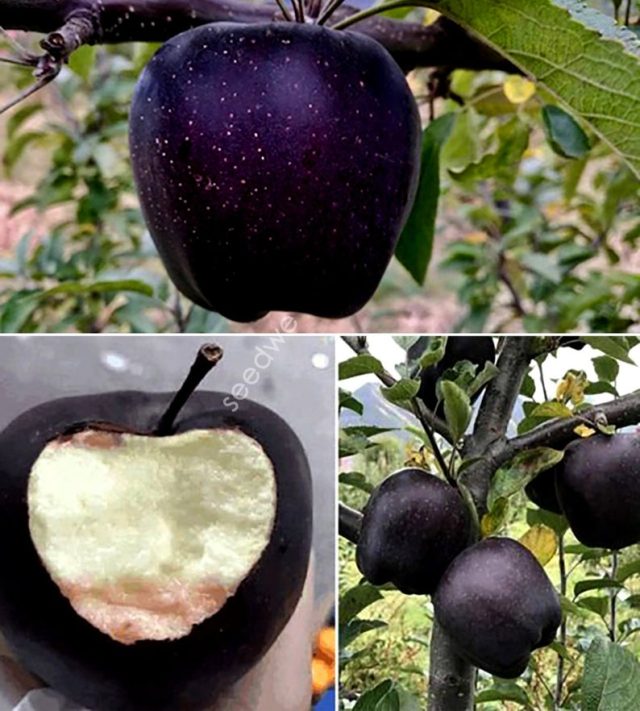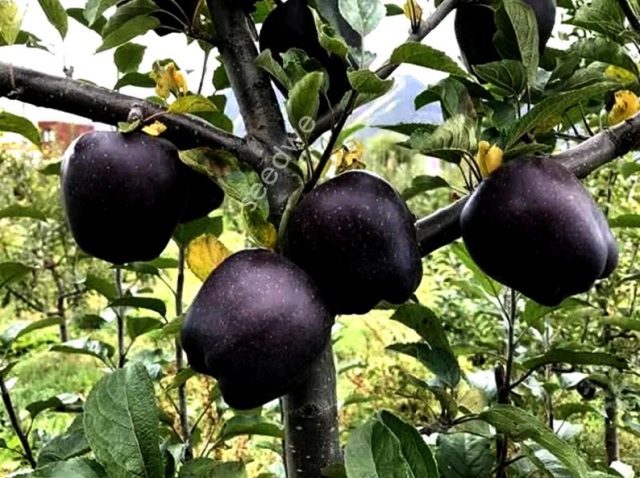The Black Diamond Apple is a rare breed from the family of Hua Nia apples that is cultivated in the Tibetan region of Nyingchi. Despite what the name suggests, the apple rather is a purple hue, with a white pulp on the inside. The seeds are available in the link below…
Prepare a garden soil plot in the fall as you would for planting any other type of seeds. Make a furrow that is no more than 1 to 2 times deeper than the longest dimension of the seed. Cover the seeds with a light cover soil and add 1 to 2 inches of sand over the row. This will prevent crusting of the soil which inhibits germination.
Next, place a wire screen over the row. Push the edges of the screen several inches into the soil on all four sides. This prevents chipmunks and squirrels from digging up the seeds. The following spring carefully watch the seeded area closely for newly germinated seedlings. As they grow, remove the wire screen to prevent bending of the new plants.
Place your seeds in the fridge. Seeds need a period of exposure to cold temperatures called “after-ripening”. This is essentially simulated winter. During this time, the seeds will begin to grow roots and sprout. They will need to be left in there for 70 to 80 days. Keep the temperature the seeds are stored at around 40 to 50ºF (4.4 to 10ºC), with optimal temperature being 40 to 41ºF (4.4 to 5ºC).
If possible, do this during actual winter so that when you take the seeds out of the fridge, they will be aligned with the actual seasons. Planting your sprouts in the early spring after the last frost will have the best results.
Check every so often to make sure the towel stays damp. It is important to keep the towel damp while the seeds are in the fridge, so check them daily. However, keep in mind that the seeds will not sprout while they are in the fridge.
Prepare your pot and soil. Your seeds will need to be planted outside in a prepared seedbed or in a pot. Use a good potting mix. Apple seeds grow best in soil with a neutral pH level. Fill the pots with the soil and create a divot in the soil that is one to two times larger than the sprouted seed. Do not add any fertilizer. It is not necessary, though you can add leaf mulch or compost if you want to give you seedling an extra boost.
Place the seed in the divots of soil. Put the seeds into the soil divots and then cover them, making sure to gently pat the soil down. Water the seed immediately so that the soil settles around the seed and the soil stays moist.
Keep the pot at room temperature. While growing in the pot, the seed and soil should be kept at, or slightly higher than, room temperature. The seed should have access to sunlight for a good part of the day, so putting it in a windowsill that gets sunlight for some of the day is a good idea.
Watch your seedling for growth. Several weeks after planting, your seeds should begin to start throwing up little leaves. From there they will grow taller and stronger. Keep them in pots until they look strong and any risk of frost has passed. If you think your seedling is outgrowing its pot, transplant it to a larger pot and keep watering it daily.
Please note before buying and read the following below before you buy:
You need to do your own research for successful germination. Advice provided is intended as a guide only and does not guarantee success. Seeds are live products that rely on many important factors such as grower skill, planting time, seed depth, soil type and weather conditions to grow. Germination is affected by many factors that are out of the control the seller (Seedwe – KollaX ) and although we do everything we can to get seeds to you in the best possible condition, once you receive your seeds, it is out of our hands. Therefore, we can take no responsibility for any successes or failures you may encounter whist growing our seeds.
Find the seeds HERE…
















